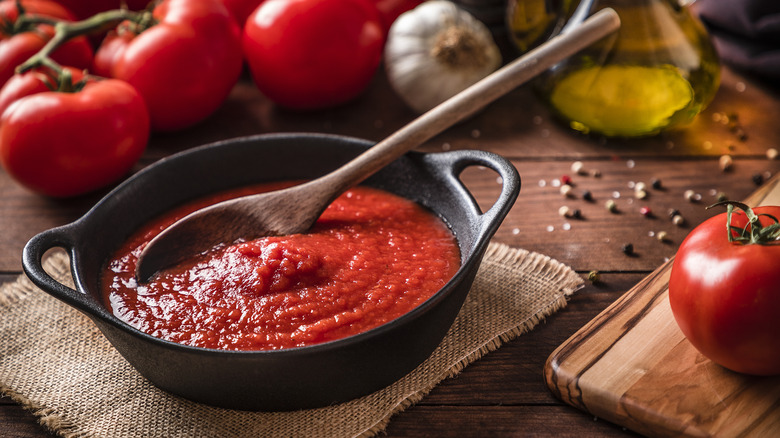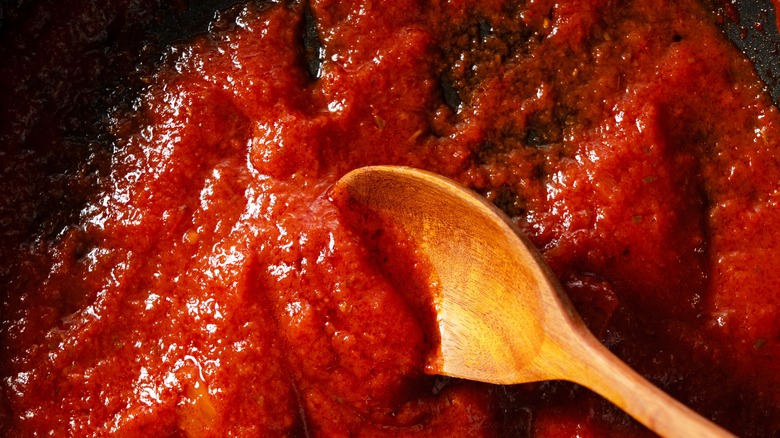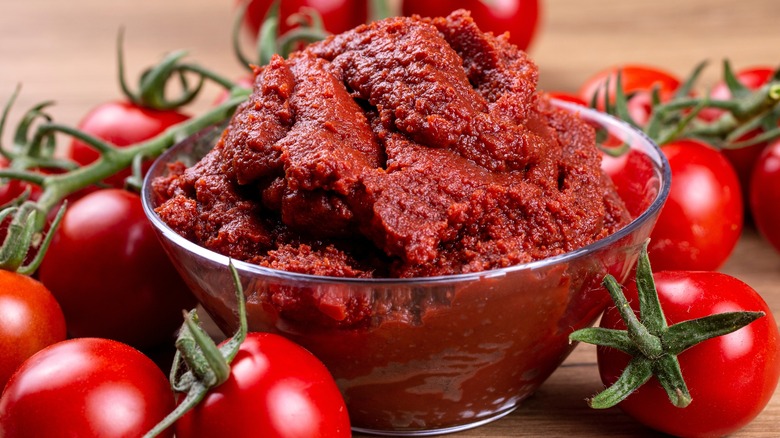The Best Way To Thicken Tomato Sauce Without Changing The Flavor
There are tricks you can use to get your sauce to stick to your noodles for a satisfying, saucy bite: Use bronze die cut pasta, mix a splash of starchy water in with your sauce, and finish cooking your pasta in the sauce. But if your sauce is watery by the time your pasta's done cooking, there's not much you can do — you're going to be stuck with a thin tomato broth and barely-sauced noodles. The fastest methods, unfortunately, will completely change the flavor and style of your sauce (like adding heaps of cheese, cream, or making a roux). If you want a bright tomato sauce or marinara (there is a difference) but need to thicken it up, there's only one answer. You have to take the time to cook it down more.
Evaporating the excess water content by cooking it longer is truly the only way to thicken your sauce without dramatically changing the flavor. The flavor will change a little — it will intensify as it concentrates — but the general balance of your sauce will remain the same.
Depending on how much time you have and how much attention you can give your sauce as it reduces, you can either simmer or boil it to thicken it up. Boiling the sauce (with the lid off, of course) will work faster, but you run the risk of burning the sauce at the bottom of the pan. Simmering will take longer, but there's less burning and splattering to worry about.
How long does it take to boil down sauce?
Although it depends on everything from the surface area of the sauce to atmospheric pressure and humidity, water generally evaporates at a rate of 1% to 2% per minute at a vigorous boil. It will take approximately an hour to boil off a liter of water. It's very unlikely you'll need to boil off a whole liter of water, so this process won't take an hour, but how long it takes will depend on how much sauce you have and just how watery your sauce really is.
If time is of the essence but you have an abundance of open burners and extra pots, you can hurry things along by dividing the sauce between multiple pots and set them all to boil. This increases the surface area, encouraging more evaporation than leaving the sauce in one deep pot.
As you're cooking the sauce down, be sure to give it a good stir every so often. Not only will this keep the bottom from burning, but you may also be closer than you think. As the sauce boils down, the thicker, denser sauce will slip to the bottom and the thinner, more watery sauce will float on top. Stirring may reveal that the sauce is thicker than it seems.
Last ditch efforts, if all else fails
Cooking the sauce down will, of course, reduce the volume of sauce you have. If you're really in a bind for time or can't afford to lose total volume, there is a next-best trick you can use: Tomato paste. Adding the thick tomato paste will naturally thicken up the sauce, but be aware it will also skew the flavor. Because it's so concentrated, it may make your sauce too sweet or change the balance of your seasonings. Be ready to re-season the sauce after you add it.
Tomato paste straight out of the container is also, well, not very tasty. Don't add it straight to your sauce raw. Be sure to brown the paste in a skillet with some olive oil before adding it into your sauce to prevent that metallic tang from making your sauce taste like the inside of a soup can.
Adding tomato paste will change the flavor less than adding heaps of cheese, cream, or a roux, but it will still change the flavor of your sauce — especially if you're making a bright, fresh pomodoro sauce. If possible, delay dinner with a little appetizer and another glass of wine, and just let the sauce cook down more before you start your pasta. It will be worth it.


